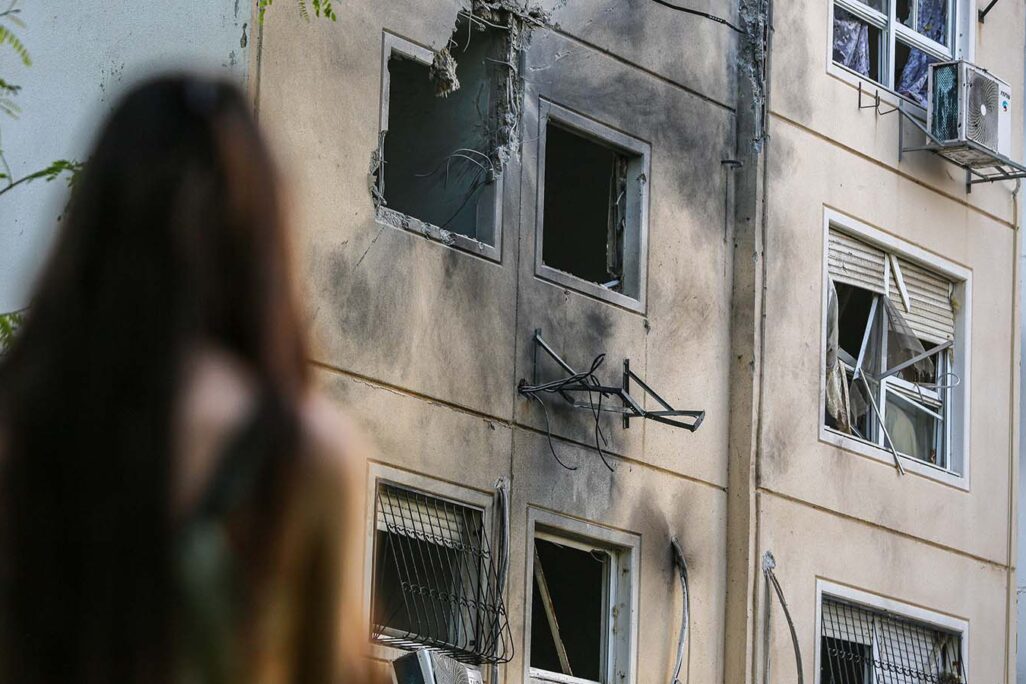
Olei HaGardom street is located in the Golda neighborhood of Ashkelon, the southernmost neighborhood in the city. As Ashkelon is only 12.5 kilometers from the Israel-Gaza border, it came as no surprise when Israel’s Home Front Command called for the immediate protection of about 10,000 housing units in the city, many of which are located in this neighborhood, at the start of the fighting between Israel and Gaza earlier this month.
“Those who are able to will seek shelter in Barnea [a safer neighborhood in northern Ashkelon] or head out of town. Otherwise you have to stay here [in Golda] all day in the public shelter, literally living here,” Rivka, a resident of the neighborhood, said in an interview during the flareup of rockets two weeks ago. She had to bring enough mattresses and other amenities to the public bomb shelter for herself and her four children.
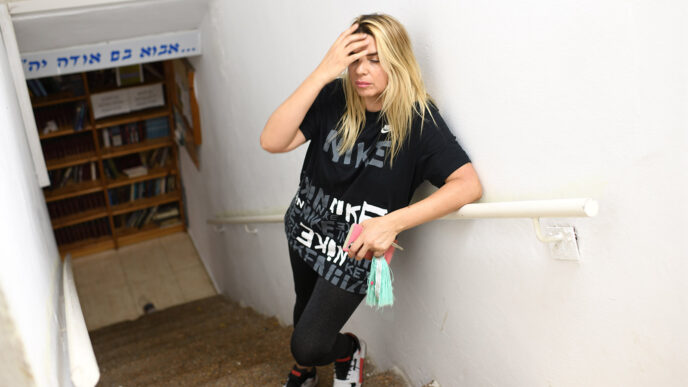
"Rockets are falling, what’s with the masks?"
In Ashkelon there are about 40,000 housing units without proper safety infrastructure (apartments without concrete-fortified safe rooms or adequate public shelters outside). The vast majority of units are in Atikot, an older area in the south of the city that was built before construction guidelines came to require the installation of safe rooms in all new buildings. According to the Home Front Command, the least secured area in Ashkelon is the Golda neighborhood in Atikot, named after Golda Meir, Israel’s first female prime minister.
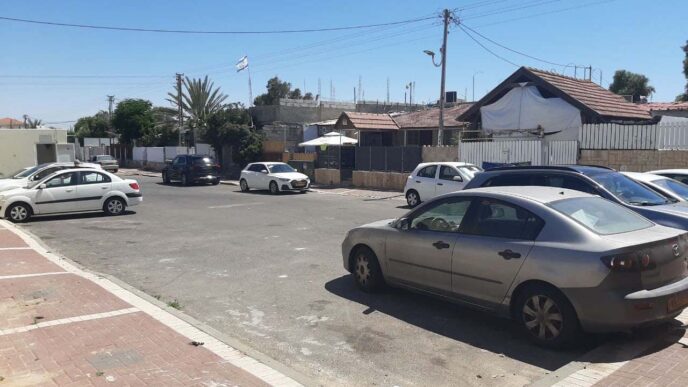
The buildings in Golda are built mostly at ground level. Unlike the rest of Atikot, residents of Golda do not even have the ability to take cover in the stairwell should a siren occur suddenly, which is considered the next best option for those living in buildings without safe rooms.
There are public bomb shelters throughout the city maintained by the Ashkelon municipality, including in Atikot. But even young and able-bodied residents of the neighborhood cannot rely on these public shelters for safety if they choose to stay in their homes until hearing the sound of a siren. It is impossible to get to the shelters from their homes within the estimated 30 seconds it takes for a rocket from Gaza to reach Ashkelon.
Those who could not find an alternative living arrangement were therefore forced to move into the local public shelter.
The hardships of such an arrangement are obvious. A public shelter is the size of an average living room. Most of the shelter is used for sleeping, and when we visited, the floors were lined with mattresses and used bedding from the previous night. Residents were forced to use public toilets. The shelter was uncomfortably cool from the air conditioning. Families brought food from home and had to store it in the entrance of the shelter.
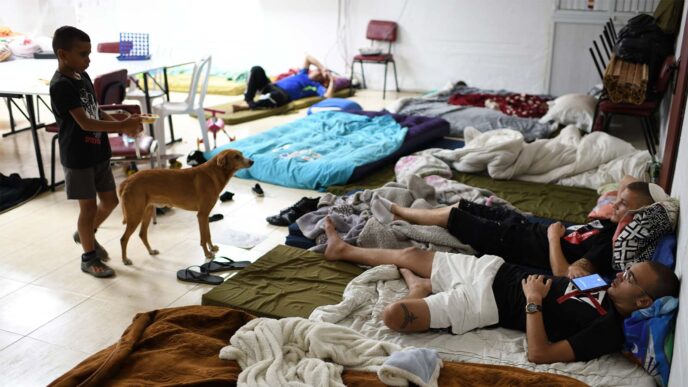
The forced proximity and the uncertainty surrounding the length of time the neighbors would remain in the shelter created considerable tension among the people seeking safety. Within minutes of our entrance, two loud arguments broke out: one between two adults quarreling over the location of the mattresses, and the other between two children. The children ended up physically fighting and adult intervention was needed.
This particular shelter we visited housed three families, but the number of mattresses indicated that at night a much larger number of people were sleeping there.
The parents were exhausted from the constant task of entertaining their children, who had been out of school since the start of the recent flare-up. Residents stayed inside the shelter most of the day. By midday, some were still in their makeshift beds. Some, having already put away their mattresses and bedding, sat watching the incessant news coverage coming from the television. “We only turn the TV off at night, and only after being shouted at,” Rivka told us.
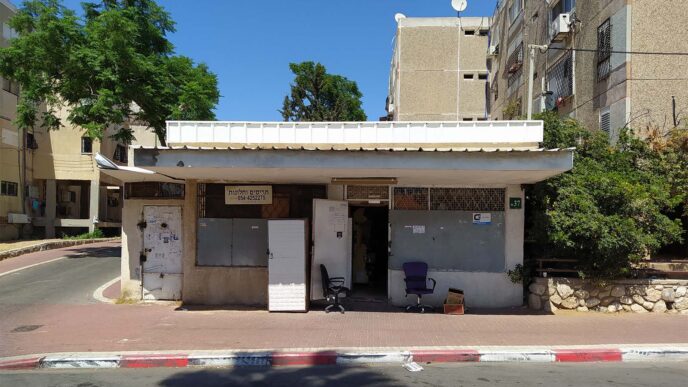
The television news coverage provided endless topics for conversations. The adults discussed each topic among themselves until the newscaster gave the signal to move on, until one of the children interrupted the conversation with a question, or until the news stopped providing enough of a distraction. A particularly diverting news item discussed the decision of Cellcom, a major Israeli telecommunications company, to briefly stop its operations in solidarity with an Arab-led strike protesting the violent riots between Jews and Arabs inside Israel.
Rivka’s husband, Shlomo, began to shout at the television, threatening to switch services and leave Cellcom entirely. “You still haven’t paid off your bills,” Rivka reminded him. And after a brief discussion on the subject, Shlomo gave up, and returned to staring angrily at the screen, quietly this time.
Outside the bomb shelter, a large sign on the wall urged residents to continue wearing masks while inside the enclosed space. (While case numbers are declining and restrictions are gradually being lifted, the COVID-19 pandemic is still present within Israel.) But within the shelter, none of the residents wore masks, and many residents found the mandate to be strange in light of the current situation.
“Rockets are falling [above us], how will a mask help me with that?” Shlomo said. “Luckily, we were vaccinated before it all started, otherwise we would have had to think twice about coming to the shelter at all,” Rivka added. “I’m not worried about [COVID-19]; what I am worried about is [making sure] that the children won’t be outside when sirens start.”
Photographing rocket interceptions from the steps of the shelter
Above ground, children played at the entrance of the shelter. After a week spent in such close proximity, a sense of mutual contempt was evident among the children as well. The frequent quarrels between them led the exhausted adults to drive them out of the central space.
The children knew to get inside when a siren sounded. But after a whole week of incessant rocket fire, some of the deterrent effect of the explosions had worn off, and the children did not always go all the way down into the shelter – instead they could be seen holding their phones toward the exit, hoping to catch a video of the Iron Dome intercepting the rockets.
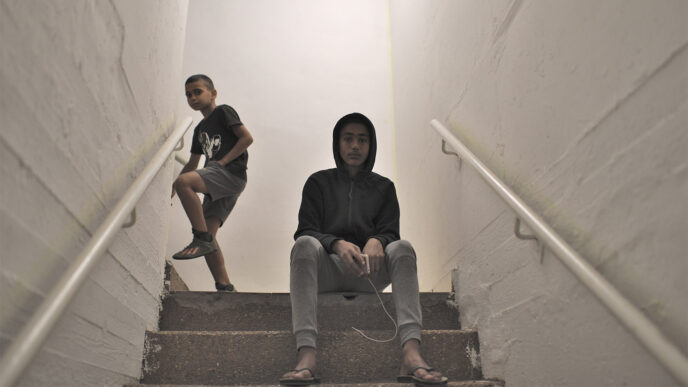
“Not everyone comes to the shelter,” Lian, 10, who had been staying in the shelter with his family since Operation Guardian of the Walls began, said. “Some of my friends go to other places, those who can. Those who have nowhere to go come to the shelter. But I don’t really mind [the whole situation]; there is no school, we do what we want. Let it stay like this. It’s fun for us.”
Children outside the shelter were discussing something else, but it was clear they were wary about sharing it with journalists. Eventually, one of the children explained: “There’s an old woman down the street who’s staying at home and hasn’t come to the shelter.”
She uses a wheelchair and lives alone, and according to him, she would rather take a risk at home than spend an indefinite amount of time inside the shelter, where she would be confined until the end of the fighting. The children seemed to decide they had already said too much, as they refused to point to the house or find out the woman’s name. “It’s her right to decide for herself, everyone does what they decide,” Lian concluded.
In the shelter with the mother of Hamas captive Avera Mengistu
Indeed, not all families in Atikot are sleeping in shelters. Some are content to stay in their apartment buildings and head into the stairwell during the sirens, preferring to stay at home despite the higher risk.
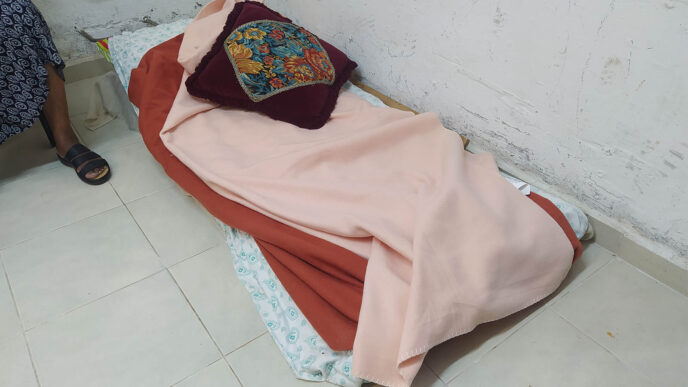
The streets in the Shimshon neighborhood were deserted at midday when we visited. Residents knew the most dangerous place to be during a siren was in a car, so they stayed in their houses. Some went out briefly for fresh air. Shopping was concentrated in one of the neighborhood convenience stores, since no one wanted to risk travelling farther from home to go to the bigger supermarkets.
Most people in the neighborhood have a shelter in the building, but that does not necessarily allow residents to stay in the apartments until the sound of a siren. Some elderly residents chose to stay in the building’s shelter rather than attempt to run down multiple flights of stairs at each sounding of a siren.
The Mengistu family – whose son Avraham, or Avera, has been held captive by Hamas for almost seven years after he crossed into Gaza during a period of psychological instability – does not have a safe room in their apartment. The mother, Agarnesh, would have to go down three flights of stairs in order to protect herself against the rockets sent to by the terrorist organization that holds her son, so she stayed in the building’s shelter most of the day. The small shelter had no air conditioner or fan. She sat among some mattresses and plastic chairs with a few other elderly neighbors spending the day together.
Despite everything, there was no hatred or desire for revenge in the air. These three elderly women did not hate anyone. On the contrary, they expressed compassion. “I am sad in my heart for their children, for the women. How the heads of Hamas run like mice in the tunnels and they die,” one of the neighbors said, referring to the Israeli Air Force’s bombardment of Gaza’s tunnel network. “I pray for the soldiers,” Agarnesh said through tears, in effortful Hebrew.
“Anyone who says they aren’t afraid is lying”
Barry and Sapir from the Faran Mechina, a pre-military training program, came to a shelter in Atikot towards the war in order to provide assistance to the residents, and especially the children. Between sirens they took the children outside, playing with toys and games that had been donated by other residents and by the Ashkelon municipality. Inside the shelter, three quiet girls put together a puzzle.
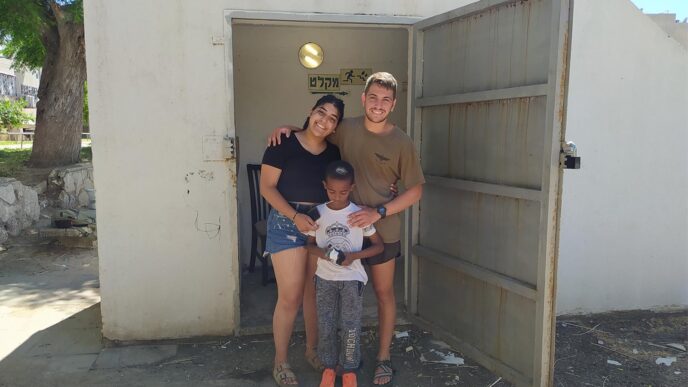
“We arrived this morning, and so far there has been only one siren. Everyone here is having fun, the children are sleeping in the shelters and the parents in the houses, and in the morning they go to eat and shower and then we play with them,” the girls said.
In the middle of a conversation with Meirav Alfasi, another resident, a siren wailed and we ran to the shelter, together with the children and other neighbors. Alfasi lives on Shapira Street and has three children of her own.
“We should get the same support like the Gaza border communities. The residents of Ashkelon are hit hard these days, there’s lots of shelling, there’s lots of anxiety,” she said. “We shouldn't stop [bombarding Gaza], we have to deter them properly, so that they think twice about firing. I sleep here with my mother and children and not at home. Here it’s on the first floor, and it’s a little more sheltered.”
In the shelter, after the alarm sounded, she said, “Despite all the fear, we need to go all the way and deter them. Next time they’ll be scared. It is very difficult for us, there is no routine, no school.”
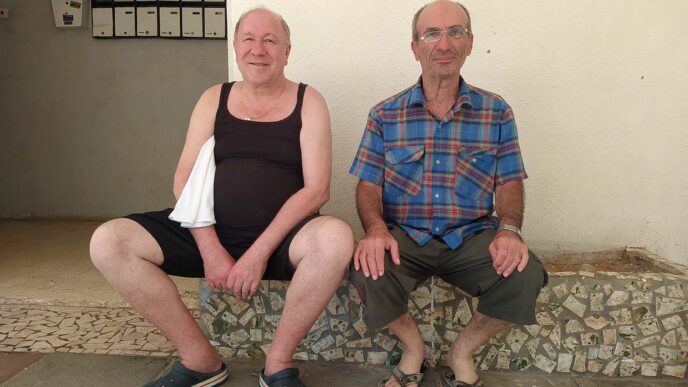
Residents Rafael and Yevgeny sat on the concrete bench outside the block, between alarms. They were at once eager to talk to someone and afraid of the media.
“We live here, everything is fine, people are healthy,” Yevgeny said, trying to convey a relaxed atmosphere, despite the alarm three minutes prior. “The truth is, it is quite tense,” Raphael said. “We don't get to the shelter quick enough – there is no time and we only manage to get to the stairwell.” When asked if it’s scary, Raphael responded: “Even the concrete is shaking, so of course I'm scared. Anyone who says they aren’t afraid is lying. I’ve lived here for fifty years, and I don’t remember such tension occurring.”






